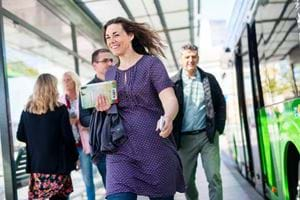Travel after the pandemic
Remote working, cancelled or audience-free events, school closures and advice not to travel – there were many reasons why travel with Nobina’s buses fell significantly during the Covid-19 pandemic. Now, when there are increasing signs that the pandemic is ending, questions arise as to what the new normal will be. Has there been a fundamental change in the way people behave? Will they avoid travelling by public transport?

“This concern is unwarranted. On the one hand, travel during the pandemic instead demonstrated the role and importance of public transport, and on the other hand, after a crisis, people quickly tend to want to return to previous travel patterns,” says Daniel Mohlin, Head of B2C at Nobina.
Similar experiences include the SARS outbreak in Hong Kong and Taiwan in 2003, the 9/11 terrorist attacks in the US in 2001, and the terrorist attack on the London underground in 2005. These events created a fear of travelling by public transport, but travel returned quite rapidly to normal levels.
Data shows that public transport’s share of total travel declined during the pandemic as people opted for other means of transport, such as bicycles or cars. The group that has mainly refrained from travelling by public transport is those with access to their own car. The share of those who regularly use public transport was unchanged. Studies suggest that remote working will remain common even after the pandemic. Few people though have this option. The main public transport users – school pupils, teachers and healthcare workers – must travel to their workplaces.

“If we include the impact of higher unemployment and continued concern about the risk of infection, we expect travel by our buses to be slightly lower immediately after the pandemic. But as people still want to remain mobile and travel we expect a strong recovery within the near future.”, says Daniel Mohlin.
Nobina’s analyses of travel flows during the pandemic show changes that indicate tremendous potential for the development of public transport. In areas where travel fell most, the Nobina operates in growing, non-cyclical markets in the Nordic region, where the urbanisation trend is strong. Society is advancing and in consequence our daily lives are becoming more complex. We are becoming older. Digitalisation is proceeding rapidly with new opportunities emerging every day. All these changes create a growing need for our services. greatest impact was noted on morning traffic, while the afternoon rush hour started earlier and more people travelled in the middle of the day. This greater travel flexibility could have significant positive effects on public transport efficiency.
“Many digital industries allow great flexibility and adaptation to individual needs, and these are becoming increasingly important for the mobility of people. This will require new types of tickets and digital sales channels, faster and more flexible traffic planning and an emphasis on strengthening people’s perception of the advantages offered by public transport. This has the potential to create a bright future for public transport. The challenges facing our cities of congestion and pollution are best managed by encouraging sustainable and space-efficient mass transit systems, such as BRT and prioritised bus routes,” concludes Daniel Mohlin.